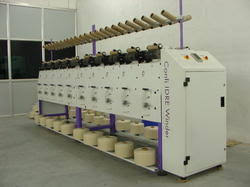Sewing machine
A sewing machine is a machine used to sew fabric and materials together with thread. Sewing machines were invented during the first Industrial Revolution to decrease the amount of manual sewing work performed in clothing companies. Since the invention of the first working sewing machine, generally considered to have been the work of Elias howe and Englishman Thomas Saint in 1790, the sewing machine has greatly improved the efficiency and productivity of the clothing industry.
Home sewing machines are designed for one person to sew individual items while using a single stitch type at a time. In a modern sewing machine, the process of stitching has been automated so that the fabric easily glides in and out of the machine without the inconvenience of needles, thimbles and other tools used in hand sewing. Early sewing machines were powered by either constantly turning a handle or with a foot-operated treadle mechanism. Electrically-powered machines were later introduced.
Industrial sewing machines, by contrast to domestic machines, are larger, faster, and more varied in their size, cost, appearance, and task.
(1) To calculate the number of machine necessary for daily production quantity in each process.
The number of machines necessary for each process,
Time for each process X daily production quantity
= …………………………………….......................
Work time per day
(2) Calculation method of the number of required machines according to the difference of production quantity per shift
The number of required machine,
Production quantity per shift after change
= The number of each machine X ………………….............……………................
Production quantity per shift
(3) Calculation method of the number of required machine according to the difference of persons
The number of required machine,
The machine of persons per shift after change
= The number of each machine X ……………………………........................….....................
The number of person
(4) Calculation method of the production quantity per year according to the different of work days per year. The production quantity per year is calculated on the basis of 280 days per year in this document. When the number of work days per year is different, use the following formula to obtain the production per year.
The production quantity per year,
Work days per year after change
= Production per year X ………………………….......................…......
280 days
(7) Method of the number of persons according to the difference of production quantity per shift
Production quantity per shift after change
The number of persons = Number of persons X ……………………..............……………............
Production quantity per shift
(8) Calculation method of production quantity per shift according to the different of the number of persons
From (formula 2),
Production quantity per shift,
The number of persons after change
= Production quantity per shift X …………………………………........
The number of persons











0 Comments